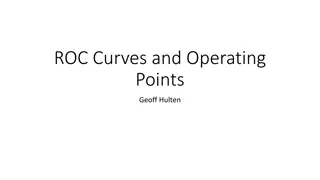Model Literasi Informasi dan Perumusan Masalah dalam Desain Komunikasi Visual
Materi ini membahas model literasi informasi, langkah-langkahnya, serta perumusan masalah dalam konteks Desain Komunikasi Visual. Mahasiswa akan mempelajari berbagai keterampilan dan langkah dalam mengolah informasi, merumuskan masalah, dan menentukan sudut pandang. Model-model literasi informasi se
1 views • 27 slides
Building a Macrostructural Standalone Model for North Macedonia: Model Overview and Features
This project focuses on building a macrostructural standalone model for the economy of North Macedonia. The model layout includes a system overview, theory, functional forms, and features of the MFMSA_MKD. It covers various aspects such as the National Income Account, Fiscal Account, External Accoun
2 views • 23 slides
NAMI Family Support Group Model Overview
This content provides an insightful introduction to the NAMI family support group model, emphasizing the importance of having a structured model to guide facilitators and participants in achieving successful support group interactions. It highlights the need for a model to prevent negative group dyn
6 views • 23 slides
Entity-Relationship Model in Database Systems
This article explores the Entity-Relationship (ER) model in database systems, covering topics like database design, ER model components, entities, attributes, key attributes, composite attributes, and multivalued attributes. The ER model provides a high-level data model to define data elements and r
1 views • 25 slides
REST API Basics and Traditional Web Applications
Explore the fundamental concepts of REST API and traditional web applications, including client-server interactions, the role of HTML and HTTP, drawbacks of traditional approaches, the significance of APIs, different types of web APIs, and the principles underlying Representational State Transfer (R
4 views • 21 slides
Communication Models Overview
The Shannon-Weaver Model is based on the functioning of radio and telephone, with key parts being sender, channel, and receiver. It involves steps like information source, transmitter, channel, receiver, and destination. The model faces technical, semantic, and effectiveness problems. The Linear Mod
1 views • 8 slides
Meaning, Thought, and Reality in Linguistics
Delve into the fascinating realm of semantics and linguistic theories, where the interplay between language, thought, and reality is deciphered. Concepts like reference, denotation, and the relationship between linguistic expressions and the world are explored through the works of renowned linguists
1 views • 37 slides
Atomic Structure: Electrons, Energy Levels, and Historical Models
The atomic model describes how electrons occupy energy levels or shells in an atom. These energy levels have specific capacities for electrons. The electronic structure of an atom is represented by numbers indicating electron distribution. Over time, scientists have developed atomic models based on
1 views • 5 slides
ROC Curves and Operating Points in Model Evaluation
In this informative content, Geoff Hulten discusses the significance of ROC curves and operating points in model evaluation. It emphasizes the importance of choosing the right model based on the costs of mistakes like in disease screening and spam filtering. The content explains how logistical regre
8 views • 11 slides
The OSI Model and Layered Tasks in Networking
The content highlights the OSI model and layered tasks in networking, explaining the functions of each layer in the OSI model such as Physical Layer, Data Link Layer, Network Layer, Transport Layer, Session Layer, Presentation Layer, and Application Layer. It also discusses the interaction between l
2 views • 41 slides
Regression Diagnostics for Model Evaluation
Regression diagnostics involve analyzing outlying observations, standardized residuals, model errors, and identifying influential cases to assess the quality of a regression model. This process helps in understanding the accuracy of the model predictions and identifying potential issues that may aff
2 views • 12 slides
REST and RESTful Web Services
REST, which stands for Representational State Transfer, is an architectural style for designing networked applications. It revolves around the concept of resources and how to represent and manipulate them in various ways. REST emphasizes a client-server communication model and offers a simple, inter
1 views • 33 slides
MFMSA_BIH Model Build Process Overview
This detailed process outlines the steps involved in preparing, building, and debugging a back-end programming model known as MFMSA_BIH. It covers activities such as data preparation, model building, equation estimation, assumption making, model compilation, and front-end adjustment. The iterative p
0 views • 10 slides
Proposal for Radio Controlled Model Aircraft Site Development
To establish a working relationship for the development of a site suitable for radio-controlled model aircraft use, the proposal suggests local land ownership with oversight from a responsible agency. Collins Model Aviators is proposed as the host club, offering site owner liability insurance throug
0 views • 20 slides
Unions Post-Weber: Representational Responsibilities For Human Rights
This presentation by Claire Mumm from the University of Windsor Faculty of Law discusses the impact of expanded jurisdiction over human rights issues post-Weber on unions' representational responsibilities for their members. It delves into the changes in DFR case law, claims against unions at Human
0 views • 37 slides
UBU Performance Oversight Engagement Framework Overview
Providing an overview of the UBU Logic Model within the UBU Performance Oversight Engagement Framework, this session covers topics such as what a logic model is, best practice principles, getting started, components of the logic model, evidence & monitoring components, and next steps. The framework
1 views • 33 slides
Regression Model for Predicting Crew Size of Cruise Ships
A regression model was built to predict the number of crew members on cruise ships using potential predictor variables such as Age, Tonnage, Passenger Density, Cabins, and Length. The model showed high correlations among predictors, with Passengers and Cabins being particularly problematic. The full
0 views • 16 slides
Exact Byzantine Consensus on Undirected Graphs: Local Broadcast Model
This research focuses on achieving exact Byzantine consensus on undirected graphs under the local broadcast model, where communication is synchronous with known underlying graphs. The model reduces the power of Byzantine nodes and imposes connectivity requirements. The algorithm involves flooding va
0 views • 7 slides
Calibration of Multi-Variable Rainfall-Runoff Model Using Snow Data in Alpine Catchments
Explore the calibration of a conceptual rainfall-runoff model in Alpine catchments, focusing on the importance of incorporating snow data. The study assesses the benefits of using multi-objective approaches and additional datasets for model performance. Various aspects such as snow cover, groundwate
0 views • 16 slides
Privacy Risks and Opportunities in Big Data for Development
Big data presents both risks and opportunities for development initiatives, with the potential to enhance policy-making processes. While big data can improve the efficiency of public policy and administration, concerns arise regarding data accuracy, inclusivity, and transparency. Upholding privacy p
0 views • 17 slides
Asp.Net Core MVC - Building Web Applications with Model-View-Controller Pattern
Asp.Net Core MVC is a framework for building web applications based on the Model-View-Controller pattern. The model manages application data and constraints, views present application state, and controllers handle requests and actions on the data model. Learn about the MVC structure, life cycle, mod
1 views • 22 slides
Evolution of REST in Web Engineering
RESTful APIs have become a fundamental solution in web engineering, enabling seamless communication between systems on different computers. The historical context of REST, dating back to the late 1990s, showcases its relevance and impact on software development. The core principles of REST, such as
0 views • 11 slides
X-CAPM: An Extrapolative Capital Asset Pricing Model
This paper discusses the X-CAPM model proposed by Barberis et al., which addresses the challenges posed by investors with extrapolative expectations. The model analytically solves a heterogeneous agents consumption-based model, simulates it, and matches various moments. It explores how rational inve
0 views • 23 slides
Innovation and Social Entrepreneurship Initiatives in Higher Education
This project focuses on establishing a leading center for promoting innovation and social entrepreneurship within higher education institutions. It aims to encourage students and staff to develop creative solutions for community challenges, expand social involvement, and foster sustainable positive
1 views • 13 slides
Principles of Econometrics: Multiple Regression Model Overview
Explore the key concepts of the Multiple Regression Model, including model specification, parameter estimation, hypothesis testing, and goodness-of-fit measurements. Assumptions and properties of the model are discussed, highlighting the relationship between variables and the econometric model. Vari
2 views • 31 slides
Cognitive Model of Stereotype Change: Three Models Explored
The Cognitive Model of Stereotype Change, as researched by Hewstone & Johnston, delves into three key models for altering stereotypical beliefs: the bookkeeping model, the conversion model, and the subtyping model. These models suggest strategies such as adding or removing features to shift stereoty
0 views • 58 slides
Faculty Senate 2017-2018 Achievements and Initiatives Review
Faculty Senate in the academic year 2017-2018 achieved a lot including collaborative projects, representational work, and budget deliberations. They worked on promoting civility, collaboration with various campus entities, and played a key role in important searches and committee restructures. The S
0 views • 7 slides
Bohr's Model of the Hydrogen Atom
Exploring the significance of Bohr's hydrogen model in physics, this lecture delves into the Bohr radius, the correspondence principle, and the success and limitations of his model. Discover how characteristic X-ray spectra contribute to our understanding of atomic structures, leading to the conclus
0 views • 14 slides
Overview of RegCM4 Model Features
RegCM4 is a community model developed since the 1980s, with over 800 scientists contributing to its advancements. It features a fully compressible, rotating frame of reference and a limited area dynamical core based on the Penn State/NCAR Mesoscale Model 5 (MM5). The model uses hydrostatic and nonhy
0 views • 14 slides
Entity-Relationship Model in Databases
The Entity-Relationship Model (E/R Model) is a widely used conceptual data model proposed by Peter P. Chen. It provides a high-level description of the database system during the requirements collection stage. Entities represent things of independent existence, each described by a set of attributes.
0 views • 21 slides
Predicting Number of Crew Members on Cruise Ships Using Regression Model
This analysis involves building a regression model to predict the number of crew members on cruise ships. The dataset includes information on 158 cruise ships with potential predictor variables such as age, tonnage, passengers, length, cabins, and passenger density. The full model with 6 predictors
0 views • 15 slides
REST in Delphi: A Comprehensive Overview
Representational State Transfer (REST) is an architectural style for interacting with web services, providing a stateless connection between transactions. No official standard exists, but it is commonly used as an alternative to SOAP. RESTful services utilize HTTP verbs like GET, POST, PUT, DELETE,
0 views • 22 slides
Model Bias and Optimization in Machine Learning
Learn about the concepts of model bias, loss on training data, and optimization issues in the context of machine learning. Discover strategies to address model bias, deal with large or small losses, and optimize models effectively to improve performance and accuracy. Gain insights into splitting tra
0 views • 29 slides
Contemporary Representational Models of Attitudes
Fazio's representational model posits that attitudes are stored as summary evaluations associated with objects, influencing accessibility and behavior. Existing attitudes impact the assimilation of new information, though specific processes remain unelaborated.
0 views • 8 slides
Analysis of Multi-Wall Penetration Loss Model for HEW System-Level Simulation
In December 2014, a multi-wall penetration loss model for HEW system-level simulation was proposed by Kejun Zhao, Yunxiang Xu, and Xiaoyuan Lu from the National Engineering Research Center for Broadband Networks & Applications. The model provides more accurate calculations of penetration loss in ind
0 views • 11 slides
The Waterfall Model in Software Development
The Waterfall Model is a linear-sequential life cycle model for software development. In this model, each phase must be completed before the next can begin, without overlaps. The sequential phases include Requirement Gathering, System Design, Implementation, Integration and Testing, Deployment, and
0 views • 7 slides
Advanced Python Programming: Arrays, Exceptions, and More
Explore advanced programming topics in Python, including arrays of multiple dimensions, Python built-in types like tuples and dictionaries, and handling exceptions. Dive into representational challenges like those in Minesweeper and Hangman, and discover the significance of arrays in programming. Le
0 views • 31 slides
Clarion and Raven's Matrices
Clarion is an integrative cognitive architecture combining connectionist and symbolic elements, exhibiting dual-representational structure. The architecture addresses various aspects of cognition such as learning, reasoning, motivation, and social interaction. Implicit knowledge, operating outside a
0 views • 30 slides
TAWA Treasury Microsimulation Model of NZ Tax System
The TAWA Treasury microsimulation model is a crucial tool used for estimating costs and impacts of tax and welfare policies in New Zealand. This model aids in understanding income distribution and poverty projections, helping various government agencies and academic collaborations make informed deci
0 views • 4 slides
The MapReduce Programming Model and Algorithms
MapReduce is a high-level programming model for large-scale data processing, comparable to RDBMS in its data model. This lecture delves into the MapReduce abstraction, programming model, and examples, highlighting its use in distributed algorithms and data storage. The data model in MapReduce revolv
0 views • 24 slides







































